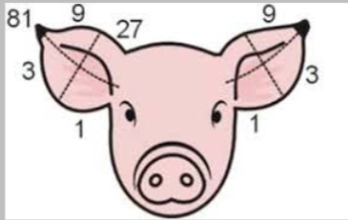SWINE Behavior, Handling, and Restraint
1/38
There's no tags or description
Looks like no tags are added yet.
Name | Mastery | Learn | Test | Matching | Spaced |
|---|
No study sessions yet.
39 Terms
Swine
Refers to the porcine species
Sow
Mature intact female
Boar
Mature intact male
Barrow
Male castrated before puberty
Gilt
Immature female, before the birth of her first litter
Farrowing
Parturition (giving birth)
Piglet
Very young, small pig, generally from birth to weaning
Shoat
Intact male, before puberty
Swine Behavior
Naturally curious, gregarious, and intelligent
Tendency to follow each other and maintain visual or body contact
Isolation is very stressful
They have a natural urge to escape (small gaps between pens, alleys, ramps, side gates)
They prefer lighted areas, oppsed to darkness which can be used to encourage movement
Social Order
One animal is dominant for the group
if a pig is removed or added, the group will fight to reestablish social order
Pig spend a lot of time doing what?
Forage-related activities, such as rooting, grazing, and exploring with their snout.
They also like to chew on objects, including each other’s ears or tails at times
What can pigs not do?
Pigs can’t sweat and this makes them susceptible to hot temperatures or conditions
This is why pigs like the mud because it helps protect their skin and cool them down.
When to avoid handling the pigs
Open mouthed breathing
Inability to move
Splotchy skin
Grunting or barking
Happens when agitated
Squeal
This is extremely loud (can exceed 85 decibels; hearing protection)
This vocalization happens when restrained or frightened
Means of defense
Biting, head-butt, or pushing with their sides
Blind Spot
They has a panoramic (310 degree) range of vision
Directly behind the animal
Swine flight zone movement
They have a tendency to move in a direction opposite of the handlers movement
An animal will usually move forward if the handler moves from the head toward the rear
To move the animal backwards, the hander should move in front of the point of balance
Sudden, deep invasion of the flight zone may cause the animal to panic
Reasons for restraint
Blood collection, Vaccination, euthanasia
Tools to aid movement
Flags, plastic paddles (rattle paddles), hog panels
DONT kick the pigs or use sticks/prods to directly hit the pigs
Pig snare
Used when necessary and if task requires restraint for a significant period of time
Loop is placed in mouth, over top jaw/snout
DO NOT move pig with snare
DO NOT tie pig up with snare
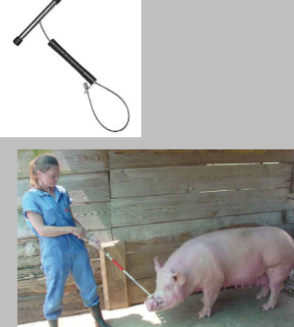
Pig snare
Pig shorting Board
Apply gentle pressure with a pig sorting board to the pig’s hindquarters and flank
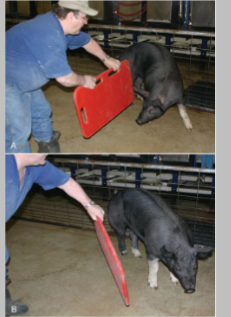
Pig Shorting Board
Rattle Paddles and Flags
Makes a rattling noise which encourages pigs to move
DO NOT hit pigs with these
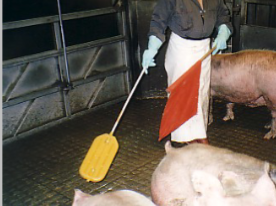
Rattle Paddles and Flags
Hog tongs
Used to grasp pig’s head behind ears
Not used very often
causes bruising
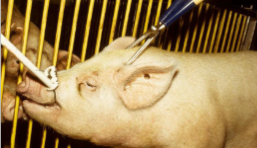
Hog tongs
Boar handling
Requires extra precautions
Boars can be very aggressive
Move or load individually
Pen separately to prevent fighting injuries
Sow handling
Requires extra time for movement
Increased aggression during estrus or at/near farrowing
Handle cautiously
Piglet Restraint
Pick up by hind leg
Avoid swinging
Alternatively: place over forearm wih its chest in your palm, legs handing on either side of arm.
NEVER pick up by ears or tails
When setting down, lower gently, front legs first
Processing Piglets
Clipping teeth (needle teeth)
Treating the umbilical cord
Iron administration
Tail docking
Identification (ear notching)
Treating splay-legged piglets
Providing supplemental nutrients
Castration
Usually done within 24-48 hours of birth. However, some producers prefer to delay some of them for 3-4 days to reduce stress on the very fragile one-day old piglet
What condition are piglets born with
They are born anemic and that is why they must receive iron
Ear notching
There are four quadrants on the ear. You can only make two notches in each quadrant. The exception is the notch in the tip of the right ear-only one notch is allowed. The get the litter number or pig number, add up the notched on the ear
Ear notching - Right Ear
Litter number
Ear notching - Left ear
Pig number
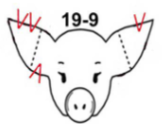
What is the litter number?
19
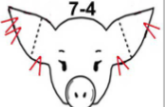
What is the pig number?
4
Quadrants for ear notching
